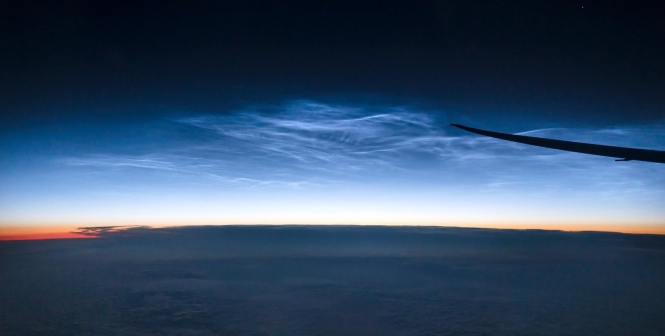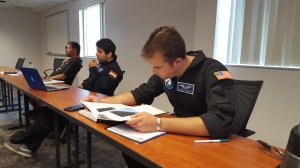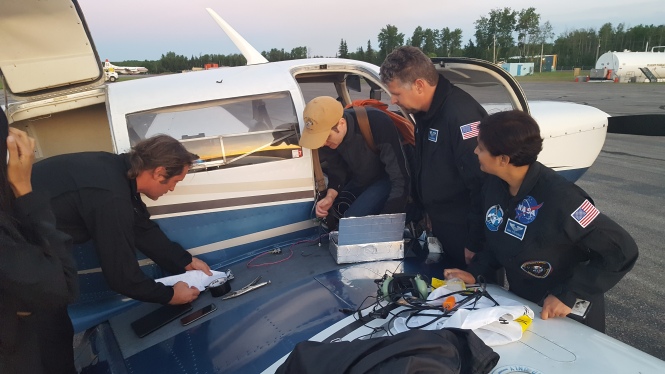Taking part in Project Possum

Perhaps the most exciting thing happening in now in spaceflight and space exploration is the emerging opportunities for almost anyone to take part in the endeavor, in some way.
The advent of private and commercial spaceflight systems and organizations is changing what astronautics means- no longer is it only the territory of federal space agencies. New pathways are being developed, from university micro satellite projects to private space stations.
Project PoSSUM is one of those pathways.
PoSSUM stands for Polar Suborbital Science in the Upper Mesosphere- in short, it’s a research project aimed at studying the unique phenomena that exist at the very edge of atmosphere. The mesosphere is a region encompassing Earth, beginning at roughly 30-40 miles (50-65 Km) and extending to 53 to 62 miles (85-100 Km), or 164,000 to 328,000 feet. It is the coldest and least dense layer of air around our planet, but also the region in which unusual near-space weather is generated.
The primary target for the investigative research pursued by PoSSUM are the noctilucent clouds found in the upper mesosphere. Dr. Jason Reimuller, the principle investigator, chief scientist and executive director of the project began exploring methods in which to better study these phenomena, endeavoring to develop technologies in which to optimize opportunities to image the elusive clouds. Noctilucent clouds are best observed- and only visible from the surface at latitudes between 50 and 70 degrees from the equator, and only in the local summer months when the atmospheric conditions allow.

Noctilucent clouds (source, google images)
The optimal conditions to view noctilucent clouds are uncommon, stymieing scientists hoping to better understand their formation, content, and variety. attempts have been made by teams to launch camera systems on sounding rockets from sub-arctic sites when the clouds were seen, with varying results. High altitude balloons have similarly been released to carry instruments into the stratosphere, but are unable to be steered to focus on the ethereal targets. Project PoSSUM hopes to one day close the distance enough to bypass these limitations- by flying researchers and their payloads on a commercial spacecraft.
Emerging commercial spaceflight entities are developing vehicles, particularly those that are designed to fly suborbital flight profiles that could provide scientists platforms for investigating high-altitude events. While media sources tend to focus on the space-tourism services being marketed, many ambitious teams in the space industry see these spacecraft as a method for carrying payloads to the edge of our atmosphere. The apogee of a suborbital parabolic arc- when such a spacecraft reaches its highest altitude before falling back to earth- will experience up to 4 minutes of microgravity (weightlessness). Not only is this a boon for scientists pursuing experiments that require the absence of gravity, but the proximity to near-space will open new possibilities for scientists investigating mesospheric features.

Significantly, the mesosphere is a region of the atmosphere in which all spacecraft that return to earth must pass through. The effect of mesospheric particulate and the ice crystals forming noctilucent clouds on spacecraft re-entering the atmosphere is not yet understood- which makes it an application for the data PoSSUM may acquire.
As an independent research initiative, PoSSUM relies on participant contributions, donors, and grants. This both limits the expenditures and frees it from oversight that hinders many university or federal laboratory programs. Accordingly, the success of PoSSUM is dependent on the dedication and discipline of its advisors and participants.
Dr. Reimuller and his team offer introductory training courses to familiarize new applicants with the project fundamentals several times each year. The initial training consists of a week of classroom lessons and practical skills instruction in topics related to the sciences being investigated. Held on the campus of Embry-Riddle Aeronautical University in Daytona Beach, Florida, applicants receive study materials and lectures from specialists in various sciences. The classroom lessons are augmented by hands-on exposure to spaceflight simulators, pressure-suit acclimatization, and exposure to extreme environments. Two off site lessons include experiencing depressurization in an altitude chamber and flights in aerobatic aircraft. 
With operating “human tended payloads” in mind, the curriculum in the initial training emphasizes the conditions of near-space environment. Lessons on human physiology and exposure to rarified air intend to prepare applicants for understanding the unique suborbital environment.
Applicants to the project should have a general background in the sciences, medicine, or engineering, or applied trades which employ technical skills. Understanding the principles of aeronomy and the associated fields is often a divergent path from most applicant’s background. Even with my undergraduate education in geography and understanding fundamental navigation techniques, I found the concepts to be challenging.

Following completion of the initial “Scientist-Astronaut” training, participants in Project PoSSUM are eligible to take part in follow-on courses designed to better prepare them for the risks associated with where the various research campaigns are being conducted. For example, participants are encouraged to take part in wilderness survival, field medicine, and egress & water survival classes, all focused on “worst-case scenarios” that may occur when operating aerospace vehicles. Many of these courses are taught by PoSSUM graduates that have specialized training or experience in the subject matter.

Advanced Egress training, April 2018
I’ve participated in two such courses thus far- one being an introductory water survival class, and the second being an applied egress test incorporating a spacecraft mock-up and pressure suits. Not unlike the basic water survival lessons I received in the service, the training consisted of immersion and escape procedures necessary to egress a vehicle that has ditched in a body of water (as opposed to a planned landing). Participants had to demonstrate an ability to escape a device simulating the cabin of aerospace vehicle after it was submerged- sometimes upside down and in the dark.

The advanced course incorporated a true-to-scale space capsule, simulating a spacecraft not unlike the NASA Orion vehicle. Representing a notional spacecraft, this mock-up seated four test subjects in place of astronauts, and featured two different egress hatches from which we had to escape. Participants in these tests demonstrated wearing a commercial spacesuit design- from escaping the capsule to entering and exiting a life raft. These tests proved that such events- water recovery or bailout into the ocean are considerably more life-threatening than often portrayed.
The significance of completing these emergency preparedness courses is to discipline participants to take part in the applied citizen-science campaigns. As Project PoSSUM continues to develop and mature the technologies associated with the eventual suborbital payload, incremental investigations are conducted to discover data associated with elements of future near-space missions.

An example of an applied citizen-science campaign that I took part in was an effort to image noctilucent clouds from an aircraft in 2017. Using a small high performance airplane, PoSSUM participants flew from High Level, Alberta, not far from the 60th parallel in order to take advantage of the sub-arctic “midnight sun”.  Crews were selected from the participating PoSSUM graduates and took part in planning the paths of the flights. The flights in turn were coordinated with ground teams equipped with scopes to image the phenomena, allowing for triangulation of targets. Despite inclimate weather, considerable data were acquired, helping researchers to better understand the conditions in which the noctilucent clouds can be observed as well as adapting the technology in order to do so.
Crews were selected from the participating PoSSUM graduates and took part in planning the paths of the flights. The flights in turn were coordinated with ground teams equipped with scopes to image the phenomena, allowing for triangulation of targets. Despite inclimate weather, considerable data were acquired, helping researchers to better understand the conditions in which the noctilucent clouds can be observed as well as adapting the technology in order to do so.
I flew on one of these flights, helping to navigate while the mission specialist operated the camera assembly. We flew the Mooney at FL180 (eighteen thousand feet above sea level), an altitude that required supplemental oxygen for the crew. The challenge of the flight was maintaining the intended flightpath while ensuring we could aim the camera at the proper angles where we predicted the noctilucent clouds were to be.

The High Level campaign was a success, acquiring considerable imagery from which scientists can investigate the nature of near-space atmospheric clouds. Researchers and volunteers from amongst the PoSSUM participants helped to process the imagery, a benchmark for citizen science. From an operational perspective, the campaign provided lessons from which project participants can apply to future coordinated ground and air studies.
Another applied research study underway is the annual Microgravity Campaign. In cooperation with the Canadian National Research Council, Project PoSSUM and private company Integrated Space Services plans and conducts flights that simulate microgravity for the purpose of conducting experiments in a space-like environment. Just like the infamous NASA “vomit-comet” flights, a modified commercial aircraft is flown by the NRC in order to replicate the lack of gravity.

Repeated iterations of the microgravity tests allows the participating institutions the opportunity to assess the results obtained and make necessary changes on subsequent flights. Each year, the number of and complexity of payloads flown has increased. The latest campaign included the winner of an international STEM competition to provide an opportunity for girls to participate in citizen science.

The primary experiment conducted during the annual microgravity campaign is the feasibility tests of the Final Frontier Design intra-vehicular activity (IVA) pressure suit. Final Frontier Design is a startup space technology manufacturer that is specializing in developing commercial spacesuit suits for the emerging industry. In a partnership with Project PoSSUM and ISS, FFD has included the company’s IVA suit in the campaigns, allowing for PoSSUM graduates to serve as test subjects wearing the suit in microgravity.

Flight 4 test Team, October 2019
Using a heavily modified business jet (Dassault Falcon 20), the Canadian NRC is able to provide an adaptable platform for diverse payloads. Flown in a series of parabolic arcs, the apogee of each allows for roughly 20 seconds of microgravity, perfect for demonstrating a space-like gravitational environment.
I’ve had the pleasure of flying on three of the microgravity campaigns thus far. From 2015 until 2019, Project PoSSUM and its commercial partners sought to determine the effectiveness and viability of using the FFD IVA suit in microgravity, such as might be experienced in suborbital space. My role in these tests has been as a Suit Assistant, concerned with the safety of and aid to test subjects wearing the IVA suit; and as Test Director, tasked with coordinating the various onboard experiments, crew, and ensuring all events are completed on the test card.

The author free-floating on a parabolic flight to test a commercial spacesuit design, 2015
It is the goal of Project PoSSUM, as per the NASA Flight Opportunities grant program to fly an imaging device tended by a human operator aboard a commercial space vehicle when the technology is ready. That applies both to the instruments being tested to collect imagery of the target noctilucent clouds as well as any commercially available suborbital spacecraft. That being the case, there is considerable research and development still necessary before any PoSSUM participants may (someday) fly.

Aerobatic flight familiarization, 2015
Unlike the traditional human spaceflight pathways, endeavoring to pursue an unproven direction offers both unforeseen challenges and innovative solutions. Not only are there risks in the timeline of designing and constructing a viable payload, but there is also the tenuous availability of a platform- in this case, a commercial spacecraft. The industry is currently developing several examples, all of which could be options for PoSSUM. A key principle of PoSSUM is the insistence that the payload be “vehicle agnostic”, which means it ought to be capable of being adapted to fly on whichever suborbital craft is eventually selected. Given the often protracted and dynamic nature of commercial spaceflight ventures, a patient “wait and see” policy is a healthy standpoint for the project.
Unlike many of my peers in the project, I am not a scientist or an engineer. I do not work in the space industry, either for a federal agency, contractor, or private institution. Aeronomy and atmospheric sciences were new subjects for me to absorb. Instead, I’m inclined to offer my experience as an operational aviator, incorporating my familiarity with aircrew roles and training. As the project moves forward, I hope to help enable the goals set by instilling a sense of airmanship and risk management, particular for those participants unfamiliar with flying in aerospace operations. It’s my goal to transfer the experiences I’ve accrued from 16 years of military flying to the dynamic environment of research flight ops- perhaps even spaceflight ops, should PoSSUM succeed in flying researchers someday.

Moving forward, Project PoSSUM is expanding into new directions- to include STEM outreach and EVA technologies testing. Further testing of new iterations of the FFD IVA suit will continue, as will airborne science campaigns when the resources are available. For me, opportunities to participate will be limited. It’s my goal, however, to continue to help enable the project, if and when the opportunity arises





